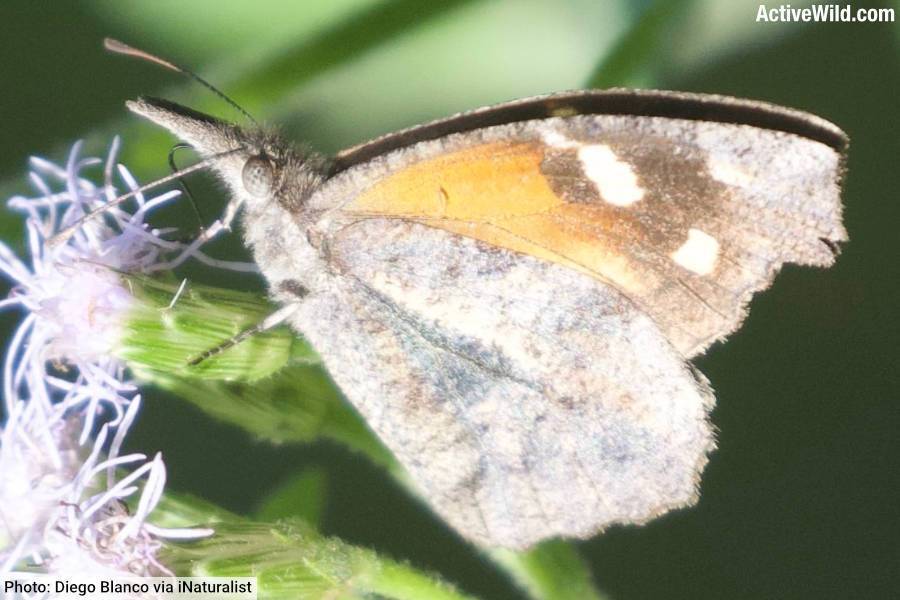
Texas butterflies pictures and facts – a list of common and notable butterfly species found in Texas.
With habitats ranging from deserts to forests, Texas is home to a vast number of different butterfly types – the state is home to an estimated 450-plus butterfly species. On this page, we list 25 common and / or noteworthy Texan butterflies.
Texas Butterflies Index
American Snout

- Scientific name: Libytheana carinenta
- Family: Nymphalidae
- Wingspan: 1.5 to 2 inches (3.8 to 5 cm)
- Main color(s): Brown, orange, white
- Where found: many parts of the southern United States, especially in Texas and surrounding states, south into South America. It is usually found in wooded areas and near rivers.
The American snout butterfly is easily recognizable by its long, beak-like mouthparts (palps) that extend from its head, resembling a snout. Its forewings are primarily brown with orange and white patterns, while the hindwings are mostly brown.
The butterfly’s elongated mouthparts, which resemble the stem of a leaf, and its foliage-like wing colors provide excellent camouflage. The species is often found near hackberry trees, which serve as their larval food source.
The American snout is known for its migratory behavior–during some years, vast numbers of American snout butterflies can darken the skies of Texas and Mexico.
Black Swallowtail

- Scientific name: Papilio polyxenes
- Family: Papilionidae
- Wingspan: 2.5 to 4.5 inches (63 to 115 mm)
- Main color(s): Black with yellow, blue, and red spots
- Where found: North America
One of Texas’s most beautiful butterflies, the black swallowtail is a striking insect with black wings adorned with yellow spots and a row of blue spots on the hind wings, with a central red spot near the tail.
Males and females differ slightly in coloration, with females generally being more subdued and having more blue than the male.
The black swallowtail is commonly found in fields, gardens, and meadows, particularly where their host plants, such as parsley and dill, are present.
The caterpillar of the black swallowtail is known as the “parsley worm” after the plant on which it is commonly found. It is either green or brown – a strategy to ensure the survival of the greatest number of caterpillars.
Cloudless Sulphur

- Scientific name: Phoebis sennae
- Family: Pieridae
- Wingspan: 2 to 3 inches (51 to 76 mm)
- Main color(s): Bright yellow to pale greenish-yellow
- Where found: Southern United States, Central America, South America, and the Caribbean
The cloudless sulphur is a vibrant yellow butterfly, with males displaying a more vivid yellow compared to the slightly paler females.
This species is highly migratory and is often seen in open areas such as fields, gardens, and along roadsides. Their larval host plants include senna and partridge pea, which are typically found in their habitat range.
Common Buckeye

- Scientific name: Junonia coenia
- Family: Nymphalidae
- Wingspan: 1.5 to 2.7 inches (38 to 70 mm)
- Main color(s): Brown with orange, white, and iridescent blue spots
- Where found: Throughout the United States (except the Pacific Northwest), southern Canada, and Mexico
The common buckeye butterfly is easily recognizable by its bold eye spots on the wings, which serve as a defense mechanism against predators. The upper side of the wings is brown with orange bands and the distinctive eye spots.
This species is often found in open, sunny areas such as fields, meadows, and along roadsides, where their host plants like plantains and snapdragons are abundant.
The common buckeye migrates as far north as southern Canada in the summer, retreating to the southern United States and Mexico during the winter.
Common Wood-Nymph
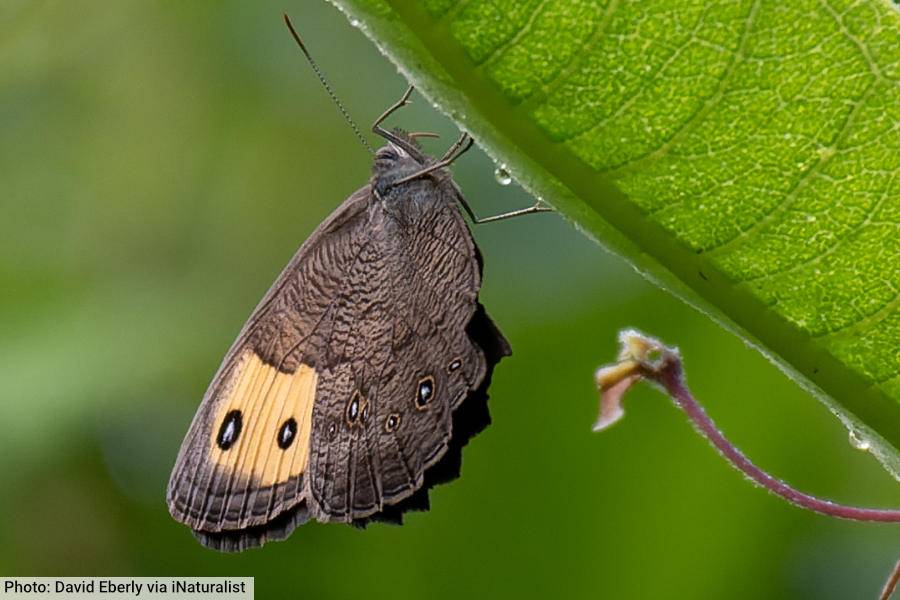
- Scientific name: Cercyonis pegala
- Family: Nymphalidae
- Wingspan: 1.75 to 3 inches (44 to 76 mm)
- Main color(s): Brown with two large yellow-rimmed eyespots on forewings
- Where found: Eastern and Central United States, parts of Canada, and the Great Plains
The common wood-nymph butterfly has a subtle yet distinctive appearance, with brown wings featuring two large yellow-rimmed eyespots on the forewings, and varying numbers of eyespots on its hindwings. It is similar in appearance to other wood-nymph butterflies of genus Cercyonis.
The common wood-nymph butterfly prefers grassy, open areas such as meadows, prairies, and forest edges. Its larvae feed on various grasses, including switchgrass and purpletop.
Dainty Sulphur
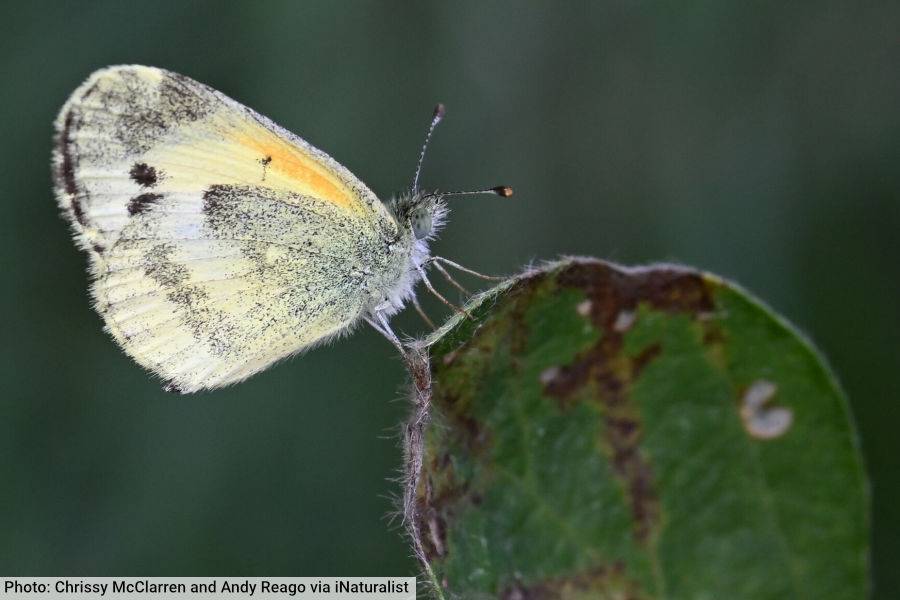
- Scientific name: Nathalis iole
- Family: Pieridae
- Wingspan: 0.8 to 1.2 inches (20 to 30 mm)
- Main color(s): Yellow with black markings
- Where found: Southern United States, Central America, and South America, occasionally in the northern United States
The Dainty Sulphur is a small butterfly (the smallest North American member of its family), notable for its bright yellow wings with distinctive black markings along the edges and tips.
Despite its small size, the species is highly adaptable and can be found in a variety of open habitats such as fields, roadsides, and disturbed areas. Its larvae feed on low-growing plants in the aster family, such as marigold and fleabane, which thrive in these environments.
Eastern Tiger Swallowtail
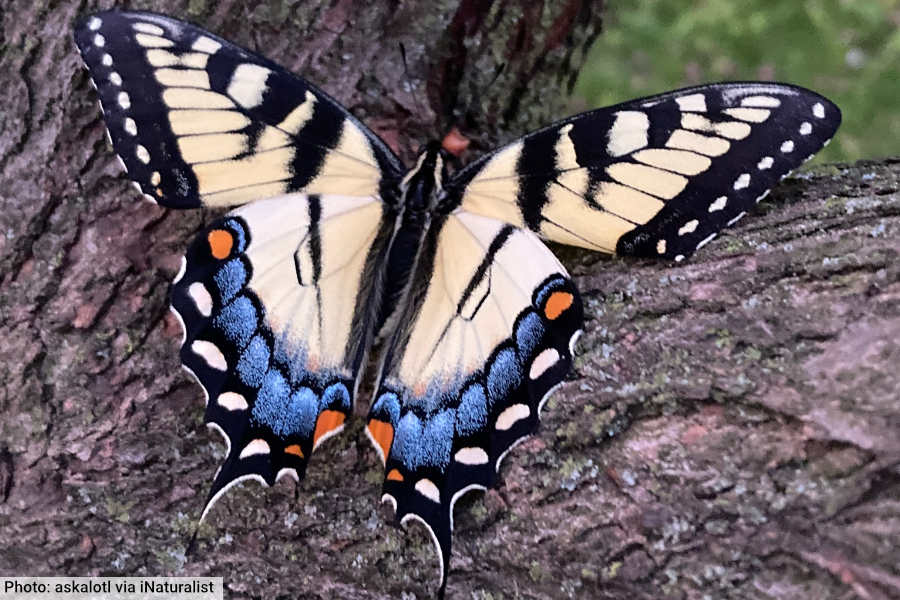
- Scientific name: Papilio glaucus
- Family: Papilionidae
- Wingspan: 3.1 to 5.5 inches (79 to 140 mm)
- Main color(s): Yellow with black tiger stripes, blue and orange spots on the hindwings
- Where found: Eastern United States, from New England to Florida, west to Texas, and the Great Plains
The eastern tiger swallowtail is a large and striking butterfly, easily recognized by its yellow wings with black tiger-like stripes. The hindwings feature blue and orange spots, with females exhibiting more blue on the hindwings compared to males.
This species is commonly found in deciduous woodlands, river valleys, and gardens. It is highly adaptable and its larvae feed on a variety of host plants, including wild cherry, tulip tree, and willow.
This well-known butterfly is the state insect of Virginia and the state butterfly of Alabama.
Giant Swallowtail
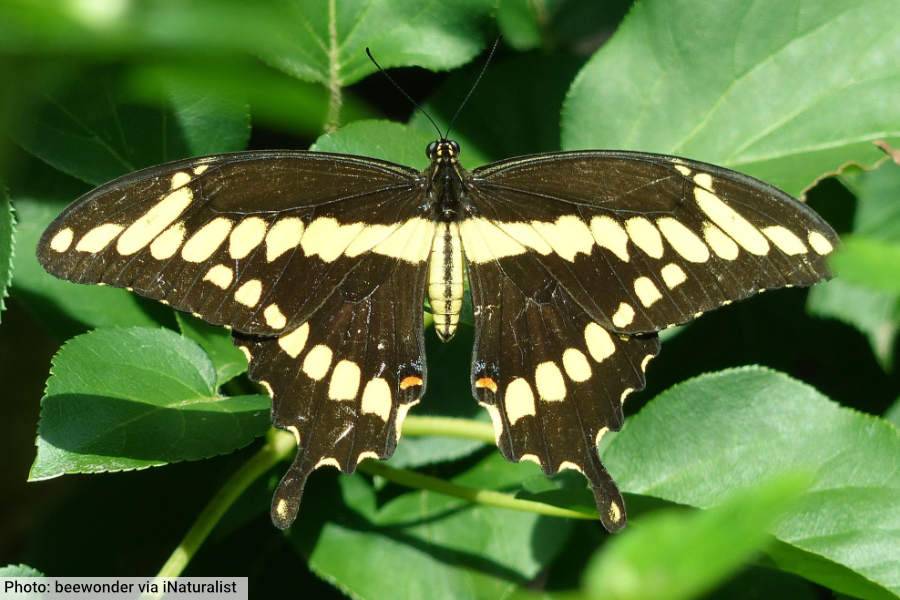
- Scientific name: Papilio cresphontes
- Family: Papilionidae
- Wingspan: 5 to 7.4 inches (127 to 190 mm)
- Main color(s): Black with yellow bands
- Where found: Southern and Central United States, parts of Canada, Mexico, Central America, and South America
The giant swallowtail is the largest butterfly not only in Texas, but in the whole of North America. It can be distinguished by its large size, black wings adorned with yellow bands, and the elongated tail streamers seen on many swallowtail butterflies. The underside of the wings is primarily yellow with blue and orange spots.
The giant swallowtail is typically found in forests and citrus orchards, and may also be seen in gardens and open woodlands. Its larvae, known as “orange dogs,” feed on leaves of citrus trees and other members of the Rutaceae family, and is regarded as a pest by commercial growers.
Great Purple Hairstreak

- Scientific name: Atlides halesus
- Family: Lycaenidae
- Wingspan: 1.25 to 1.75 inches (32 to 45 mm)
- Main color(s): Iridescent blue and black with red and orange markings
- Where found: Southeastern United States, parts of Central America, and northern South America
The Great Purple Hairstreak is a striking butterfly with iridescent blue upper wings contrasted by black borders and a bright red spot near the tail. The underside is mostly dark purple with orange spots. Extending from each of the hind wings are two tails, one longer than the other. These thin tails give the butterfly its “hairstreak” name.
This distinctive Texan butterfly is commonly found in oak woodlands, pine-oak forests, and gardens, where its larval host plants, mistletoes, grow. The adults are known for their quick, erratic flight and are often seen visiting flowers for nectar.
Gulf Fritillary
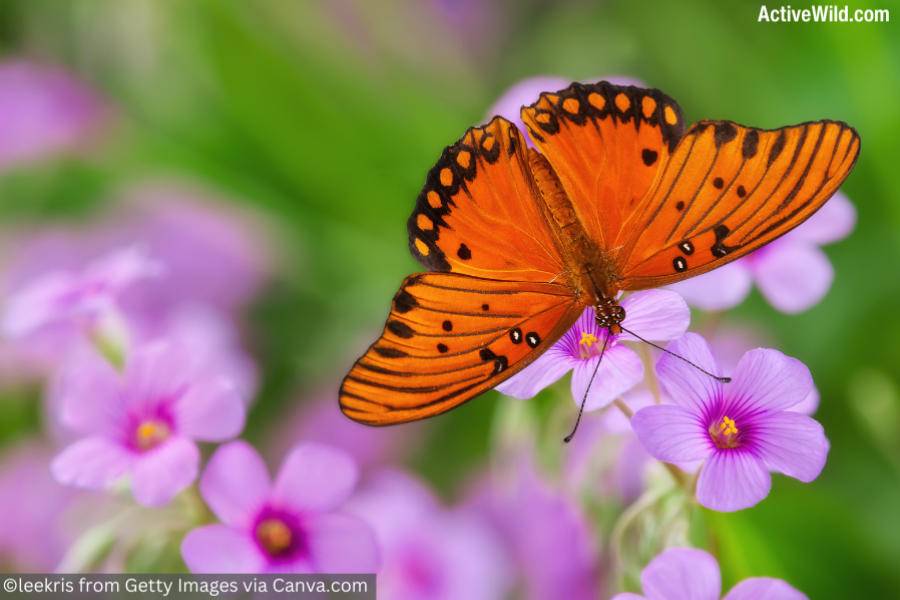
- Scientific name: Agraulis vanillae
- Family: Nymphalidae
- Wingspan: 2.5 to 3.7 inches (64 to 94 mm)
- Main color(s): Bright orange with black markings; silvery spots on the underside
- Where found: Southern United States, Central America, and South America, especially in coastal areas
The Gulf fritillary is a vibrant butterfly known for its bright orange wings adorned with black spots and lines on the upper side. The underside of the wings features striking silvery-white spots.
Like other members of the “longwing” subfamily, Heliconiinae, the Gulf fritillary has long, narrow wings. It is a rapid-flying butterfly.
The Gulf fritillary thrives in warm climates and is often found in gardens, fields, and coastal areas where its host plants, passion vines, grow.
Hackberry Emperor
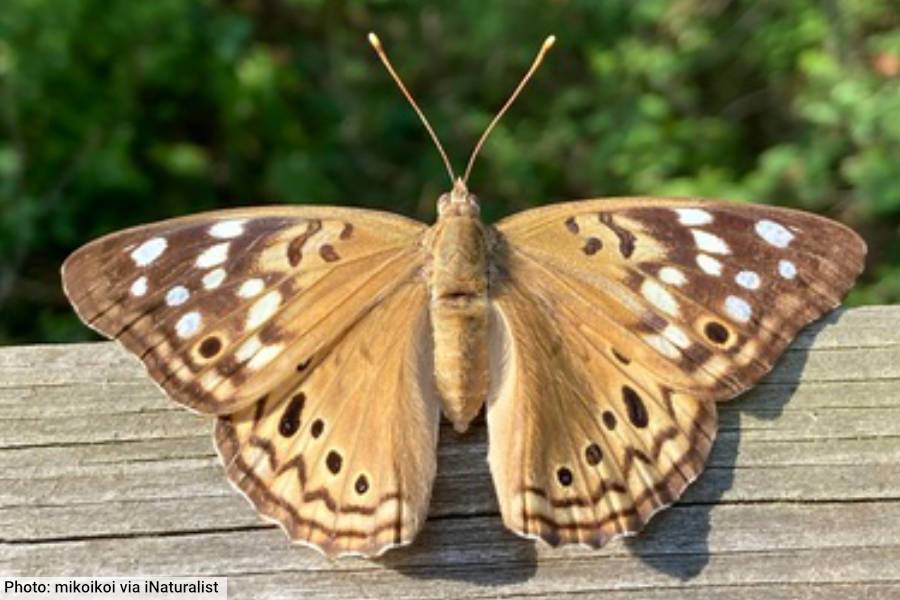
- Scientific name: Asterocampa celtis
- Family: Nymphalidae
- Wingspan: 2 to 2.6 inches (51 to 66 mm)
- Main color(s): Brown with darker brown and orange markings
- Where found: Central and Eastern United States, parts of Mexico and southern Canada
The hackberry emperor is a medium-sized butterfly characterized by its brown wings with darker brown and orange spots and bars, and small eye spots on the lower wings.
It is often found near hackberry trees, its larval host plant, in habitats such as woodlands, forest edges, and urban areas.
Known for its erratic flight pattern, the adult hackberry emperor feeds on fermenting fruit, tree sap, and animal droppings, rather than flowers.
Little Yellow
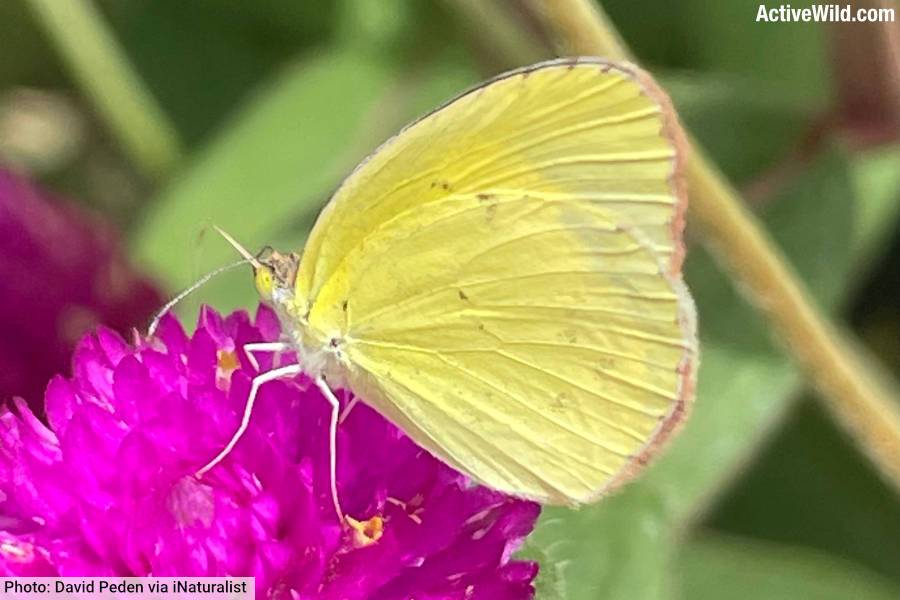
- Scientific name: Pyrisitia lisa
- Family: Pieridae
- Wingspan: 1.25 to 1.75 inches (32 to 45 mm)
- Main color(s): Bright yellow with black borders
- Where found: Southern United States, Central America, the Caribbean, and South America
The little yellow is a small butterfly with vibrant yellow wings edged with black or brown borders. The underside of the wings is paler with some brownish spots.
Found from the southern United States south to Costa Rica, the little yellow is usually seen in open, sunny habitats like fields, gardens, roadsides, and disturbed areas. Its larvae feed on plants in the pea family, such as Cassia and Senna.
The little yellow is known for its rapid, erratic flight and is frequently seen fluttering close to the ground.
Monarch
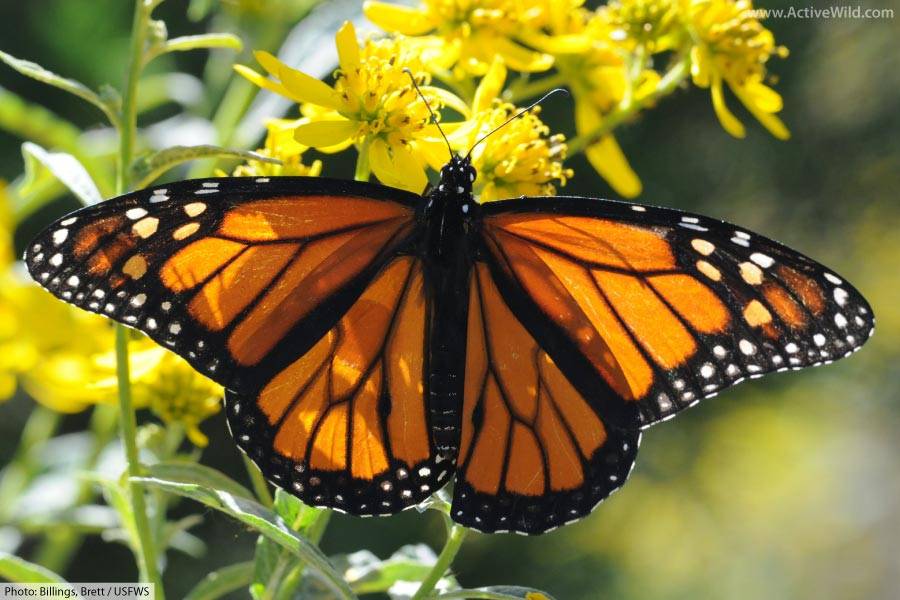
- Scientific name: Danaus plexippus
- Family: Nymphalidae
- Wingspan: 3.5 to 4 inches (89 to 102 mm)
- Main color(s): Bright orange with black and white markings
- Where found: North, Central, and South America; also found in Australia, New Zealand, and parts of Europe and Asia
One of the best-known of all butterflies found in Texas, the monarch is famous for its striking appearance and long-distance mass-migrations.
This iconic species has orange wings with black veins and white spots along the edges. During its long migratory journey, it travels thousands of miles between North America and central Mexico.
Monarchs are often found in meadows, gardens, prairies, and along roadsides. Their larvae feed exclusively on milkweed, which provides them with a chemical defense against predators.
The Monarch’s migration and lifecycle, including its transformation from caterpillar to chrysalis to butterfly, are subjects of extensive scientific study and public fascination.
Discover More With Active Wild
- You can find out more about the monarch butterfly on this page: Monarch Butterfly Facts
- Discover more about the monarch butterfly’s lifestyle: Life Cycle of the Monarch Butterfly
- See pictures of the various stages of monarch caterpillar development: Monarch Caterpillar Stages
Painted Lady
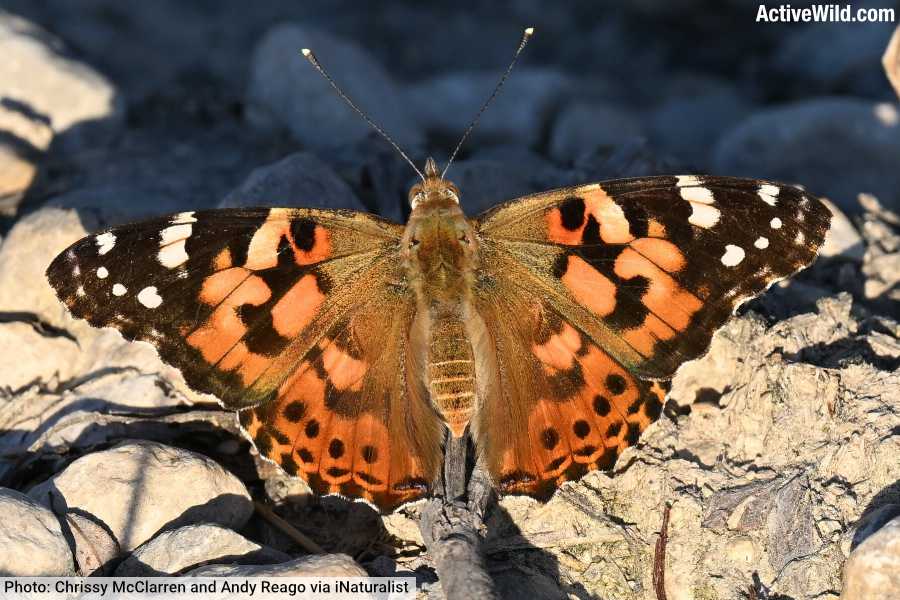
- Scientific name: Vanessa cardui
- Family: Nymphalidae
- Wingspan: 2 to 2.9 inches (50 to 74 mm)
- Main color(s): Orange with black and white markings
- Where found: Worldwide, including North and South America, Europe, Asia, and Africa
The painted lady is one of the most widespread butterfly species, found not only in North America, but also in all other continents except Antarctica and South America.
This widespread species is recognized by its orange wings with black spots and white markings near the tips. The underside of the wings is mottled brown, providing excellent camouflage.
The species inhabits a variety of environments, from gardens and meadows to deserts and tundra. The larvae feed on a wide range of host plants, including thistles, mallows, and nettles.
Known for their strong migratory behavior, Painted Ladies can travel long distances, sometimes resulting in large population explosions in certain areas. Painted ladies in the Old World migrate between Europe and Africa each year.
Pearl Crescent

- Scientific name: Phyciodes tharos
- Family: Nymphalidae
- Wingspan: 1.25 to 1.75 inches (32 to 45 mm)
- Main color(s): Orange with black markings and some white spots
- Where found: Throughout the United States, southern Canada, and northern Mexico
The Pearl Crescent is a small butterfly characterized by its orange wings with intricate black patterns and some white spots near the edges. The underside is paler with a crescent-shaped white mark, which gives the species its name.
Pearl crescents are commonly found in open, sunny habitats such as fields, roadsides, and gardens. Their larvae feed primarily on asters. The species is known for its variability in color patterns, making it a common but interesting subject for butterfly enthusiasts.
Several other members of the genus Phyciodes (a group known as the “crescents”) closely resemble the pearl crescent.
Pipevine Swallowtail
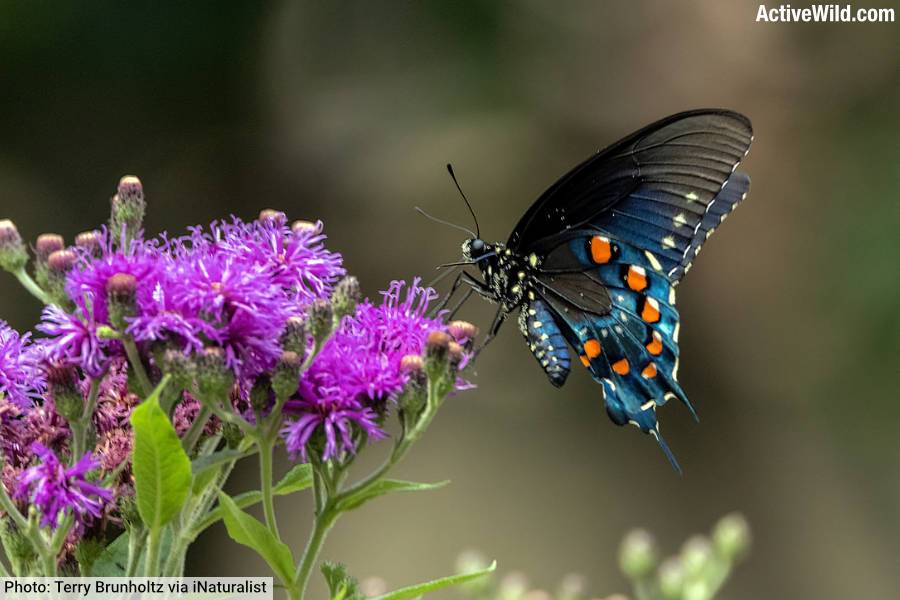
- Scientific name: Battus philenor
- Family: Papilionidae
- Wingspan: 2.8 to 5 inches (70 to 130 mm)
- Main color(s): Iridescent blue-black on the upper side; orange spots on the underside
- Where found: Eastern and Central United States, parts of the Southwest, and Central America
The Pipevine Swallowtail is one of several species of swallowtail butterfly found in Texas. (Together, the swallowtails make up the family Papilionidae.)
The pipevine swallowtail is a striking species identified by its iridescent blue-black upper wings and distinctive row of orange spots on the underside of the hindwings.
The species is often found in habitats where pipevine plants grow, as these are the primary host plants for their larvae. Typical environments include forests, open woodlands, gardens, and fields.
The Pipevine Swallowtail’s vibrant coloration serves as a warning to predators about its toxicity, which is derived from the pipevine plant. The adults are strong fliers and are frequently seen visiting flowers for nectar.
Queen Butterfly
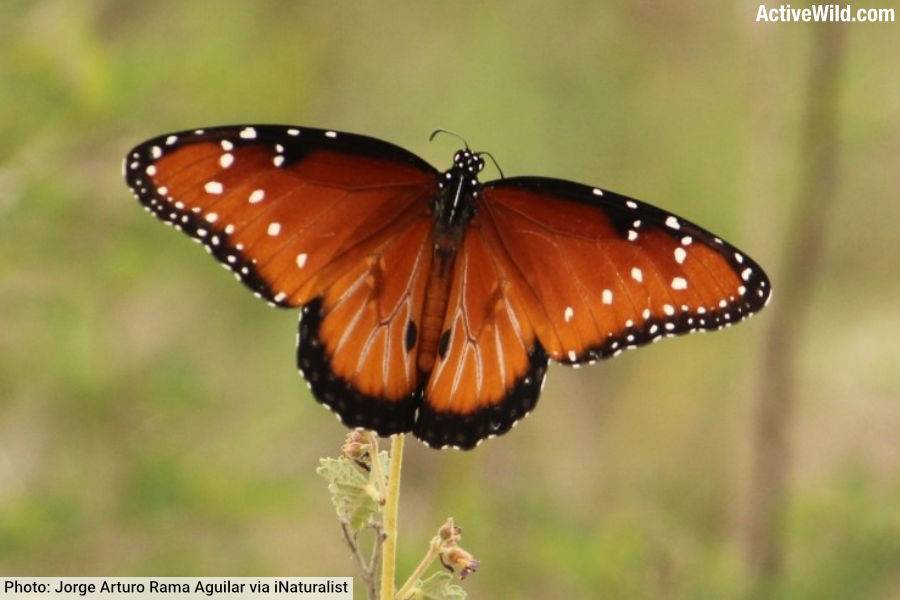
- Scientific name: Danaus gilippus
- Family: Nymphalidae
- Wingspan: 2.6 to 3.1 inches (66 to 79 mm)
- Main color(s): Reddish-brown with white spots and black borders
- Where found: Southern United States, Central America, South America, and occasionally in the southern parts of Canada
The queen butterfly is similar in appearance to the Monarch but is generally smaller and has a more reddish-brown hue. Its wings are marked with white spots and bordered with black. The undersides of the wings are paler with less prominent markings.
The queen can be found in open, sunny areas such as fields, meadows, and gardens. Like the monarch, queen larvae feed on milkweed, which makes them distasteful to predators. They are often seen fluttering slowly around their host plants or nectaring on various flowers.
Question Mark
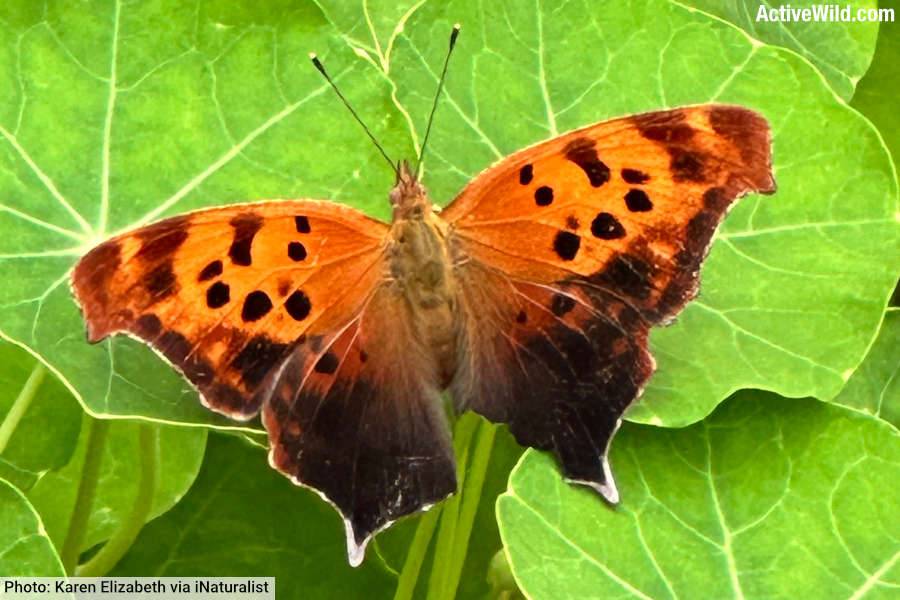
- Scientific name: Polygonia interrogationis
- Family: Nymphalidae
- Wingspan: 2.0 to 2.5 inches (50 to 64 mm)
- Main color(s): Orange with black spots on the upper side; brown with a silver comma-shaped mark on the underside
- Where found: Eastern United States, southern Canada, and parts of Central America
The Question Mark butterfly is named for the distinct silver comma-shaped mark on the underside of its hindwings, which resembles a question mark. The upper side of the wings is orange with black spots, while the underside is mottled brown, providing excellent camouflage.
These butterflies are often found in wooded areas, parks, and gardens. Their larvae feed on a variety of host plants, including elm, hackberry, and nettles. Adults are known for their rapid, erratic flight and are often seen basking in the sun or feeding on tree sap, rotting fruit, and occasionally nectar.
Red Admiral
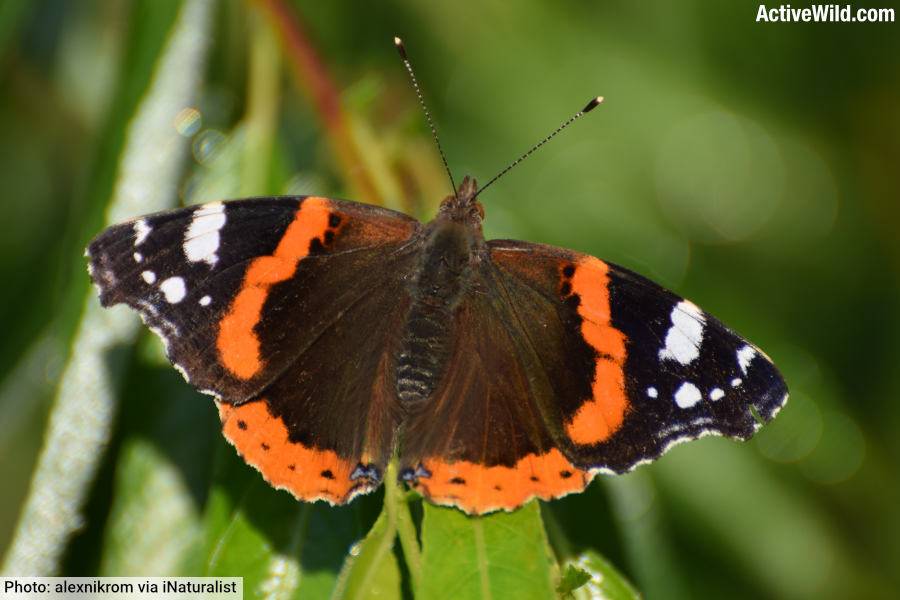
- Scientific name: Vanessa atalanta
- Family: Nymphalidae
- Wingspan: 2 to 3 inches (50 to 76 mm)
- Main color(s): Black with red bands and white spots
- Where found: North America, Europe, Asia, and North Africa
The red admiral is a striking butterfly with black wings adorned with bright red bands and white spots near the tips of the forewings. The underside is a mottled brown, which helps with camouflage.
This butterfly is highly adaptable and is found on all continents except Antarctica and Australia. It inhabits a variety of habitats, including gardens, woodlands, and meadows. The larvae primarily feed on nettles.
The red admiral is migratory, often traveling considerable distances. It is also known for its strong territorial behavior, frequently seen defending its chosen basking spots against other butterflies.
Sleepy Orange
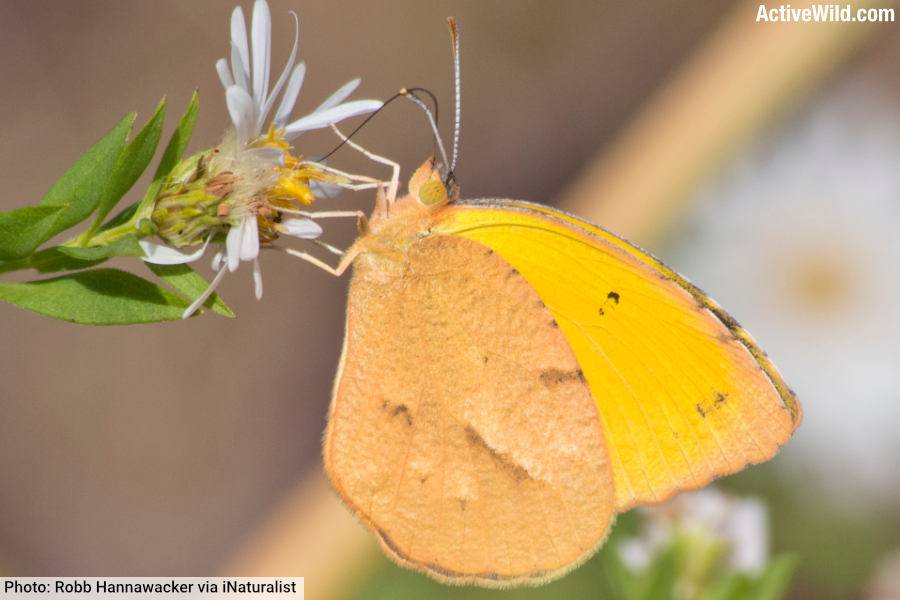
- Scientific name: Abaeis nicippe
- Family: Pieridae
- Wingspan: 1.5 to 2.25 inches (38 to 57 mm)
- Main color(s): Bright yellow-orange with black borders
- Where found: Southern United States, Central America, and parts of South America; occasionally found in the northern United States
The sleepy orange butterfly is identified by its bright yellow-orange wings bordered with black. The undersides of the wings are mottled brown and gray, providing camouflage when the butterfly is at rest.
This species is typically found in open habitats such as fields, gardens, and roadsides. Its larvae feed on plants in the pea family, especially senna and partridge pea.
The sleepy orange is said to be named either for the resting posture of its wings, which can give the appearance of a sleepy expression, or for the small black mark on its forewings, which resembles a closed eye.
Despite its name, the sleepy orange is known for its rapid, darting flight.
Southern Dogface
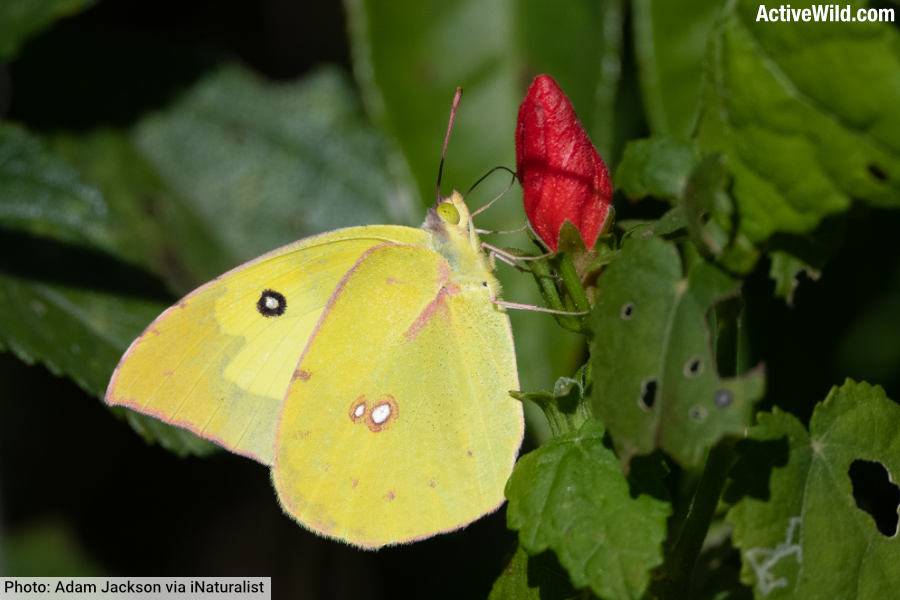
- Scientific name: Zerene cesonia
- Family: Pieridae
- Wingspan: 1.75 to 2.5 inches (44 to 64 mm)
- Main color(s): Bright yellow with black borders and a dogface pattern on the forewings
- Where found: Southern United States, Mexico, and Central America; occasionally found in the northern United States
The Southern Dogface butterfly is easily recognizable by the dogface-shaped pattern on its forewings, formed by a combination of black and yellow markings. The upper side of the wings is bright yellow with black borders, while the underside is mottled with shades of yellow and greenish-brown, providing excellent camouflage.
These distinctive butterflies are typically found in open, sunny habitats such as fields, meadows, and roadsides. Their larvae feed on various legumes, including alfalfa and clover.
The Southern Dogface is known for its swift, erratic flight and is often seen visiting flowers for nectar or basking in the sun with its wings open.
Texan Crescent

- Scientific name: Anthanassa texana
- Family: Nymphalidae
- Wingspan: 1.1 to 1.6 inches (28 to 41 mm)
- Main color(s): Black with orange and white markings
- Where found: Southern United States, Mexico, Central America, and South America
The Texan Crescent butterfly is a small species identified by its black wings with orange bands and white spots. The undersides of the wings are mottled brown.
This butterfly is typically found in open, sunny areas such as fields, gardens, and roadsides. The larvae feed on various plants in the acanthus family, such as Ruellia.
Variegated Fritillary
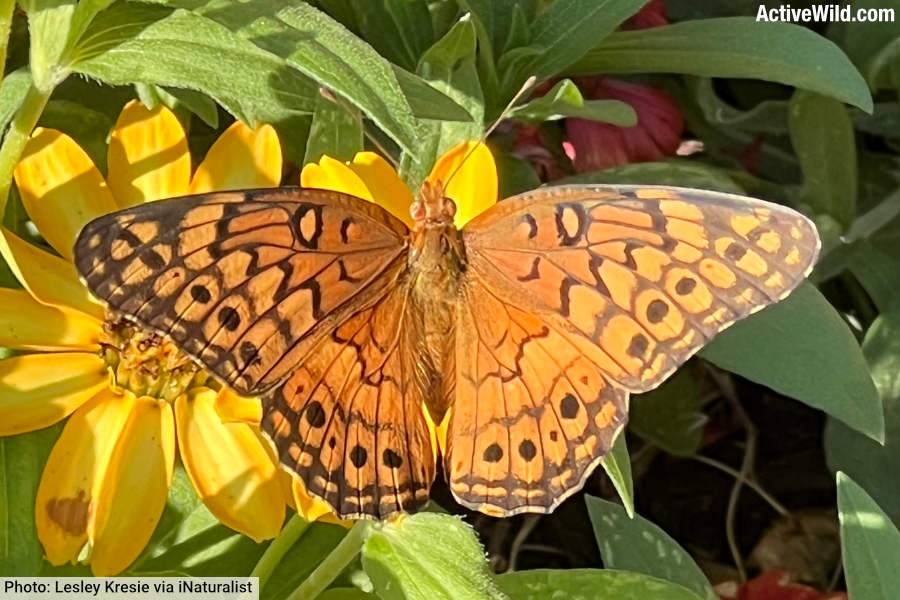
- Scientific name: Euptoieta claudia
- Family: Nymphalidae
- Wingspan: 1.75 to 3 inches (45 to 76 mm)
- Main color(s): Orange-brown with black spots and lines
- Where found: Throughout the United States, southern Canada, Central America, and South America
The Variegated Fritillary is a medium-sized butterfly with orange-brown wings marked by intricate patterns of black spots and lines. The underside of the wings is paler with more subdued patterns, aiding in camouflage.
The species inhabits a variety of open environments, including fields, meadows, and roadsides. The larvae feed on a diverse range of host plants, including passionflower, violets, and purslane.
The Variegated Fritillary is known for its strong, fast and low flight. Its generic name Euptoieta means “easily scared”; the species will usually fly away if approached.
Viceroy
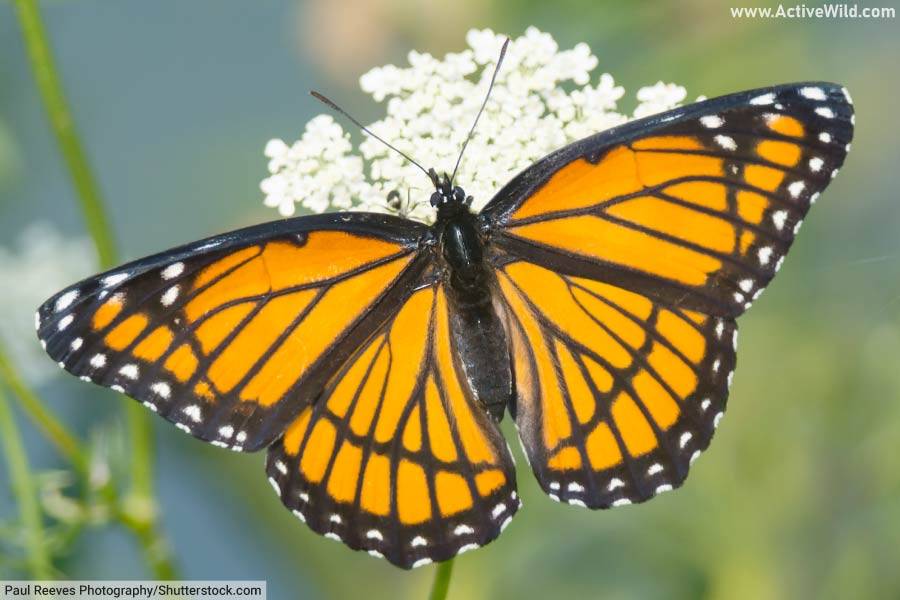
- Scientific name: Limenitis archippus
- Family: Nymphalidae
- Wingspan: 2.5 to 3.25 inches (63 to 83 mm)
- Main color(s): Orange with black and white markings, mimicking the Monarch butterfly
- Where found: Throughout the United States, southern Canada, and northern Mexico
The Viceroy butterfly is well-known for its mimicry of the Monarch butterfly, sharing a similar orange color with black veins and white spots on the wings. The key distinguishing feature is the horizontal black line that runs across the hindwings, which is absent in Monarchs.
The Viceroy’s mimicry provides it with protection from predators who also avoid Monarchs due to both species’ toxicity.
The Viceroy is commonly found in wet, open environments such as marshes, meadows, and edges of water bodies. Its larvae primarily feed on willow, poplar, and cottonwood leaves.
Zebra Heliconian
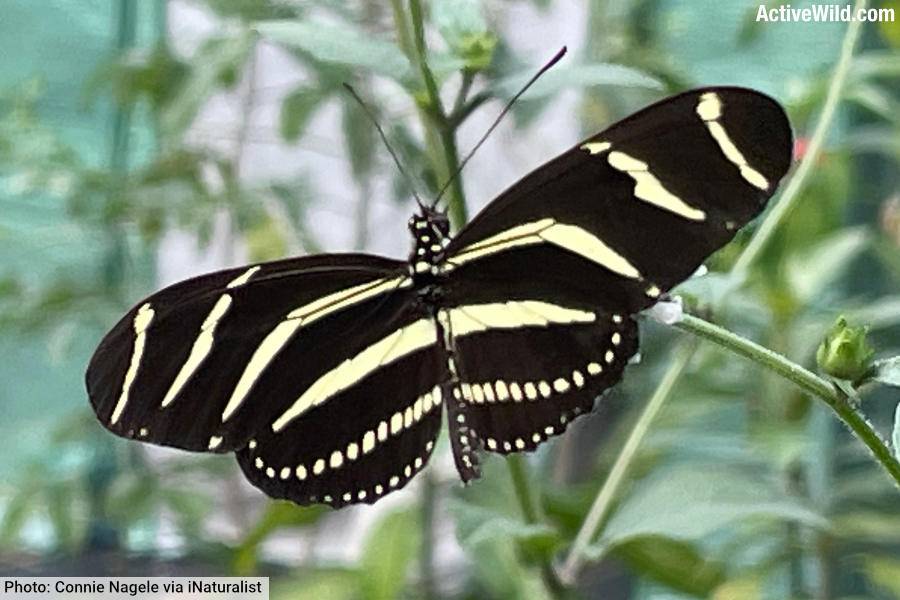
- Scientific name: Heliconius charithonia
- Family: Nymphalidae
- Wingspan: 2.75 to 4 inches (70 to 100 mm)
- Main color(s): Black with yellow stripes
- Where found: Southern United States (particularly Florida and Texas), Central America, and South America
The zebra heliconian, also known as the zebra longwing, is easily identified by its distinctive black wings adorned with bold, longitudinal yellow stripes. This elegant butterfly prefers tropical and subtropical habitats such as forests, gardens, and hammocks. Its larvae feed on passionflower vines, which provide the caterpillars with toxins that make them distasteful to predators.
Adults are known for their long lifespan and unique behavior of roosting communally at night. They feed on both nectar and pollen, which is unusual for butterflies and allows them to live longer than many other species.
The zebra heliconian is the state butterfly of Florida.
Discover More With Active Wild
Several Texas butterflies are also included on our list of the world’s most beautiful butterflies: Beautiful Butterflies
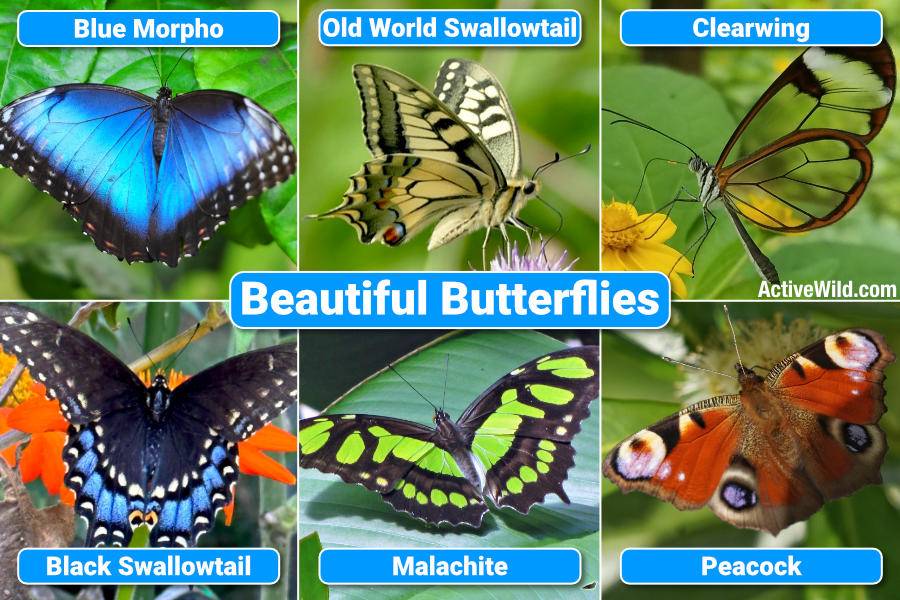
You can find out more about insects on this page: Insects – The Ultimate Guide
Discover more invertebrates on this page: List Of Invertebrates
See a list of snakes found in Texas on this page: Texas Snakes
Visit our main animals page for links to animal information and a complete guide to the animal kingdom: Animals
The post Texas Butterflies – List Of Species With Pictures & Interesting Facts appeared first on Active Wild.